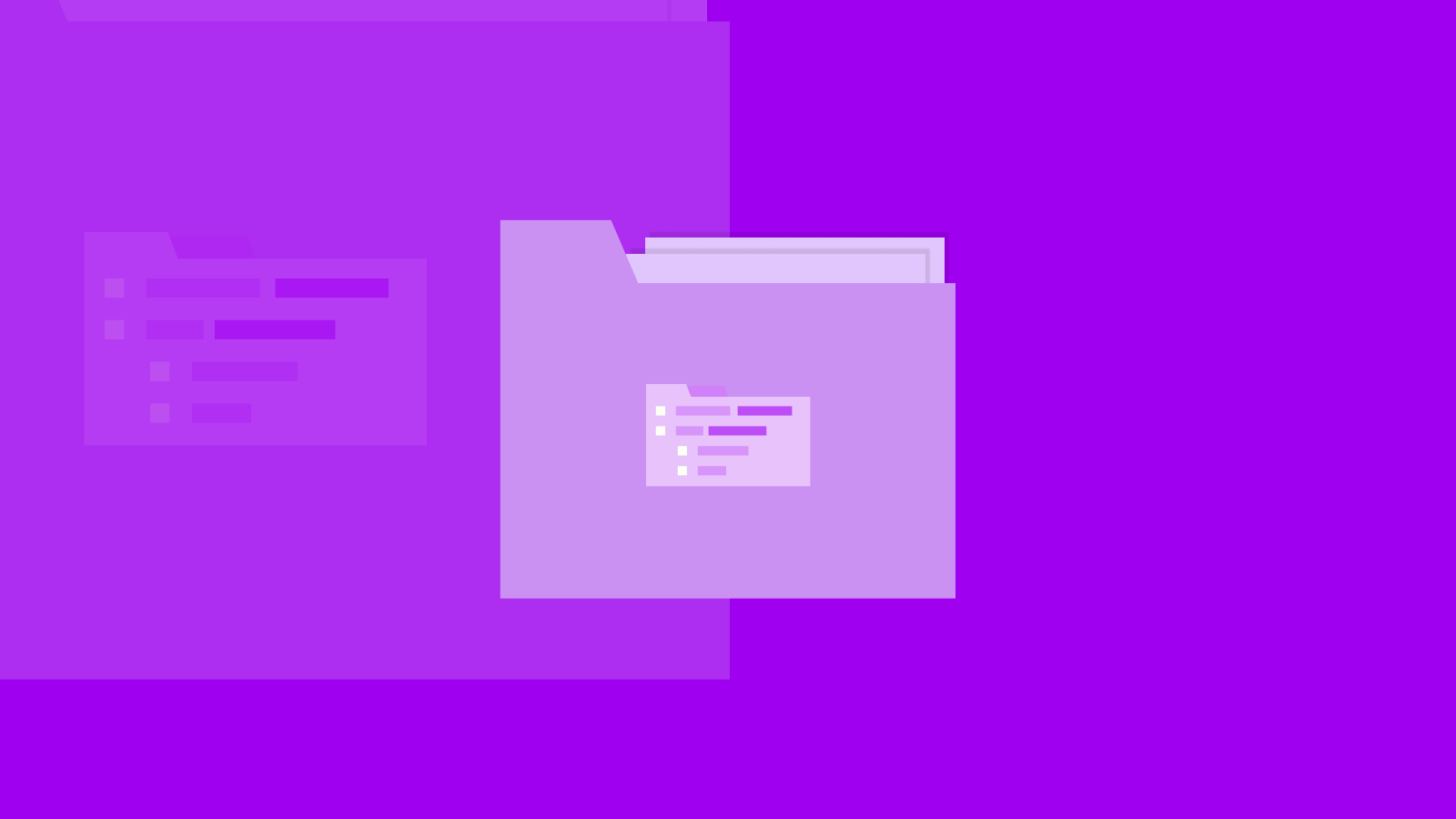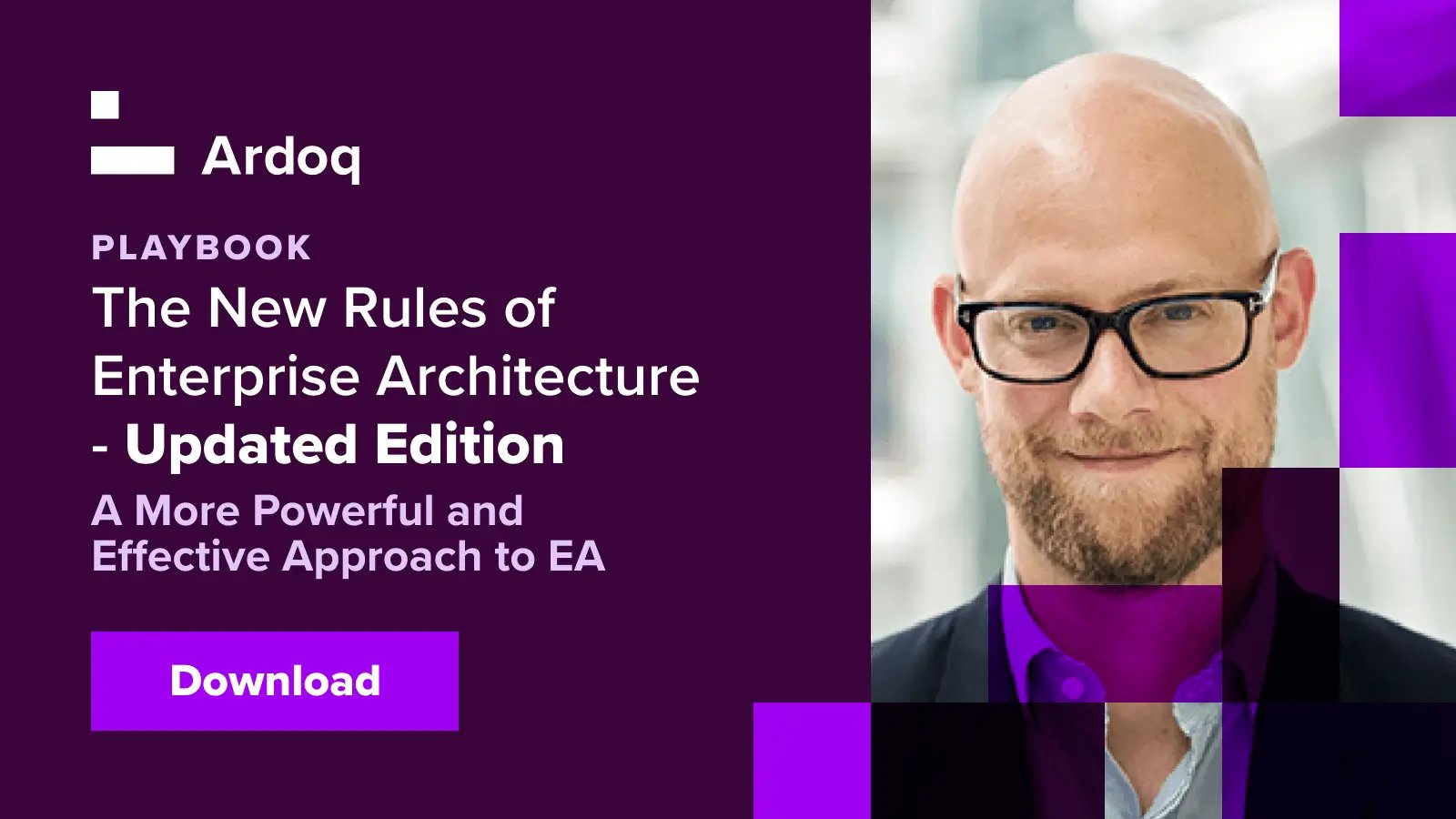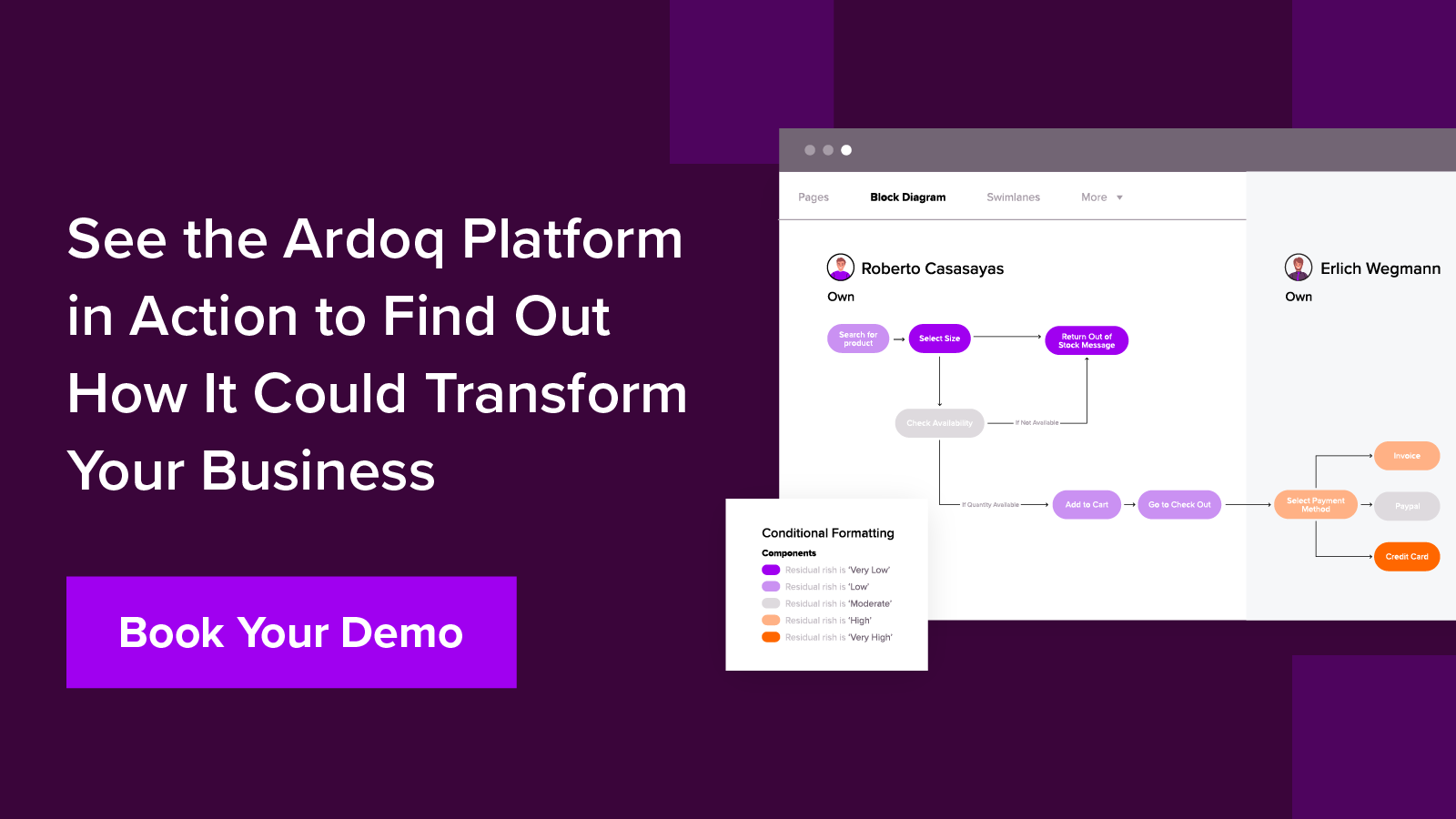Introduction
Enterprise Architecture tools are software applications that support various aspects of Enterprise Architecture management, including modeling, analysis, governance, and collaboration. The data from these platforms is critical and needs to be stored, organized, and made available to the organization. Usually, this storage point is called an Enterprise Architecture repository.
This article will describe what an Enterprise Architecture repository (EAR) is, the benefits to the organization from having an EAR, its structure, best practices for deployment, and how Ardoq supports the successful creation of an EAR.
Jump to:
- What Is an Enterprise Architecture Repository?
- 13 Benefits of an Enterprise Architecture Repository
- What Makes Up an Enterprise Architecture Repository: Structure and Components
- Enterprise Architecture Repository: Best Practices
- How Ardoq Supports Designing and Implementing an Enterprise Architecture Repository
- Create an Effective Enterprise Architecture Repository With Ardoq’s All-In-One Platform
- FAQs About Enterprise Architecture Repository
What Is an Enterprise Architecture Repository?
Outside the organization’s IT or architecture team, other departments may wonder, “What is an Enterprise Architecture repository?” and “Why do you need an architecture repository?”
The definition of an Enterprise Architecture repository is a centralized and structured storage facility where all artifacts, documents, policies, standards, models, and other relevant information about an enterprise’s architecture are stored and managed. It serves as a single source of truth for all architecture-related data and acts as a reference point for architects and stakeholders.
Why Do You Need an Enterprise Architecture Repository?
An Enterprise Architecture repository is crucial for managing and centralizing all architecture-related artifacts, including models, documents, and standards. It ensures consistency and alignment across the organization, enhancing collaboration and governance.
The EAR facilitates better decision-making by providing a detailed view and traceability of systems and dependencies. It supports regulatory compliance and improves efficiency through reusable templates and version control.
Ultimately, an EAR aligns IT infrastructure with business goals, reduces risks, optimizes resources, and enhances stakeholder communication, making it an essential tool for effective Enterprise Architecture management.
13 Benefits of an Enterprise Architecture Repository
A central repository of all information relating to an organization's Enterprise Architecture provides many potential benefits and significantly enhances the management, alignment, and effectiveness of an organization's architecture. Key benefits of an architecture repository include:
- Centralized information repository so that all architecture artifacts, documents, and models are stored in a single location, making it easier to manage and access information.
- Enriched collaboration between stakeholders, including architects, business analysts, IT staff, and executive management, through having a common platform for information sharing.
- Enhanced consistency of enterprise artifacts across the organization by reducing redundancy and helping eliminate conflicting information.
- Improved governance through enforcing compliance with standards, policies, and best practices while ensuring alignment with regulatory requirements and organizational goals.
- Informed decision-making achieved through comprehensive insights and capability analysis that assists with identifying dependencies, risks, and opportunities within the architecture.
- Improved traceability by linking business processes, applications, data, and technology components to help understand the impact of changes while maintaining control over the architecture.
- Version control management that allows for a historical record of changes and facilitates rollback to previous states if necessary.
- Increased efficiency by providing reusable templates, models, and components, which can speed up the development and update processes of architecture artifacts.
- Regulatory compliance by maintaining up-to-date documentation and adhering to prescribed standards and policies.
- Strategic alignment with business goals ensures that the IT landscape supports and enhances the business objectives.
- Risk management improved through the identification of potential risks within the architecture and the provision of mechanisms to address and mitigate identified risks proactively.
- Cost reduction by identifying redundant systems and processes, optimizing resource usage, and driving IT cost optimization.
- Scalability and flexibility through a structured approach to managing architectural changes and ensuring that the architecture can adapt to evolving business needs.
In summary, an EAR significantly enhances an organization's ability to manage its architecture effectively, align IT with business strategies, improve collaboration and governance, and make informed decisions. This leads to a more efficient, compliant, and agile Enterprise Architecture.
What Makes Up an Enterprise Architecture Repository: Structure and Components
An Enterprise Architecture repository is structured into key categories: Business Architecture, Data Architecture, Application Architecture, and Technology Architecture. Each category contains subcategories and artifacts comprising multiple components, organized hierarchically and interrelated to facilitate robust management. Such a structure usually comprises:
Top-Level Categories
-
Business Architecture including business strategy, processes, roles, capabilities, and organizational structures.
-
Data Architectures, such as data models, data dictionaries, data flow diagrams, and data governance policies.
-
Application Architecture comprising information about applications, interfaces, integrations, and application lifecycle management.
-
Technology Architecture encompassing infrastructure components, network diagrams, technology standards, and IT security.
Subcategories and Artifacts
-
Models and Diagrams such as process models, data flow diagrams, system architecture diagrams, and network topology maps.
-
Documents and Policies including standards, guidelines, policies, and procedures.
-
Metadata and Glossaries comprising descriptions, attributes, and definitions of architecture components to ensure clarity and consistency.
-
Repositories for storing different categories of data, such as service catalogs, data repositories, and asset inventories.
Relationships and Linkages
-
Traceability Links describing the connections between components to show dependencies, relationships, and impacts. An example could show how business processes are linked to applications and data elements.
-
Impact Analysis, including tools and mechanisms, to analyze the effects of changes across the architecture.
Governance and Compliance
-
Roles and Responsibilities for different architects, data stewards, and other stakeholders involved in maintaining the repository.
-
Governance Frameworks including governance structures, processes, and compliance requirements.
Version Control and Audit Logs
-
Version Histories that record changes and updates to ensure traceability and rollback capabilities.
- Audit Logs for access and modifications to maintain security and accountability.
Tools and Interfaces
-
User Interfaces including dashboards, queries, and reports for accessing and analyzing repository data.
-
Integration Points for connecting the EAR with other enterprise systems and tools such as project management, ITSM, and BI platforms.
Performance Metrics and KPIs
- Measurement Tools for evaluating the performance and effectiveness of the architecture and repository.
The structured organization of these components within an EAR ensures consistent, thorough, and efficient management of Enterprise Architecture, supporting alignment with business goals and enhancing decision-making and Enterprise Architecture governance processes.

Enterprise Architecture Repository: Best Practices
Building an effective Enterprise Architecture repository requires adherence to best practices to ensure it meets organizational needs and fosters collaboration, consistency, and efficient management of architecture artifacts. Some of the best practices to consider include:
-
Define clear objectives and scope for the EAR that align with business and IT strategies and ensure that these encompass stakeholder needs to support the decision-making processes.
-
Adopt a suitable Enterprise Architecture framework, such as TOGAF or Zachman Framework, that aligns with organizational requirements. This should offer a structured approach for capturing and managing architecture artifacts.
-
Ensure comprehensive coverage that includes all essential architecture domains: business, data, application, and technology. The EAR should also contain all necessary documentation covering standards, policies, processes, and reference models.
-
Implement robust governance structures and processes to enforce standards, maintain consistency, and ensure compliance. Also, define roles and responsibilities for managing and updating the repository.
-
Employ version control to maintain historical records of changes, enabling traceability and rollback if needed.
-
Facilitate collaboration through access to the repository, provision of tools and processes for all stakeholders, including architects, business analysts, and IT staff, and development of a common vocabulary to avoid misunderstandings.
-
Enable traceability and impact analysis to help identify relationships and dependencies between artifacts. Provide tools for performing impact analysis to understand the ramifications of changes within the architecture.
-
Provide training and support on an ongoing basis to ensure that stakeholders understand how to use the repository effectively.
-
Continuously update and improve the EAR to reflect changes in the organization’s architecture, business processes, and technology landscape. Actively seek feedback from users to identify areas for improvement.
-
Integrate with other systems such as project management, IT service management, and business analysis tools.
-
Measure performance by developing metrics and KPIs to evaluate the EAR's performance and effectiveness. Metrics can be used to guide continuous improvement efforts.
Organizations can build a robust and effective Enterprise Architecture repository by following these best practices.
How Ardoq Supports Designing and Implementing an Enterprise Architecture Repository
Ardoq supports designing and implementing an Enterprise Architecture repository through extensive features and functionalities included within the platform, such as:
-
Intuitive modeling and visualization as Ardoq offers user-friendly interfaces for creating and visualizing architecture models, allowing users to easily depict complex relationships and structures across business, data, application, and technology domains. Various diagram types and visualizations are supported, including flowcharts, dependency maps, and process models.
-
Metadata management and customization by allowing users to define custom fields and properties for architecture components. Ardoq ensures a standardized approach to capturing essential details and attributes of architectural artifacts, facilitating retrieval and analysis.
-
Advanced collaboration and stakeholder engagement features that allow multiple stakeholders, including architects, business analysts, and IT professionals, to work together seamlessly. The platform facilitates feedback and discussion through commenting and annotation capabilities. Ardoq Discover provides access to architectural information in a clean, user-friendly UI catering to non-architects in the organization.
-
Traceability and impact analysis through linking architecture components and maintaining relationships between them. It also includes powerful impact analysis tools that help users understand the implications of changes within the architecture, identifying dependencies and potential risks.
-
Flexible reporting and dashboards through customizable reporting and real-time dashboards that present key insights, metrics, and KPIs relevant to the architecture. Data-driven decision-making is supported by providing up-to-date and actionable information.
-
Governance and compliance are enforced as Ardoq supports the documentation of standards, policies, and procedures within the repository, facilitating compliance tracking with regulatory requirements and internal standards.
-
Integration capabilities with other Enterprise Architecture tools and systems, including project management, IT service management, and business intelligence platforms. Such integration facilitates a holistic view of the architecture within the broader organizational context, ensuring alignment with overall business strategies.
-
Automation and smart insights leverage automation features to keep the repository updated, reducing manual effort and the risk of outdated information. Continuously updated information provides reliable insights and recommendations to help users optimize and improve their architecture.
-
Scalability and flexibility allow organizations to grow and adapt their repository as their architecture evolves. Flexible configurations allow the organization to tailor the repository to specific organizational needs and use cases.
-
Training and support resources to help organizations effectively implement and utilize the platform, ensuring a smooth onboarding experience and ongoing assistance.
By offering these capabilities, Ardoq supports organizations in efficiently designing, implementing, and maintaining a robust Enterprise Architecture repository, ensuring alignment between IT and business, enhancing collaboration, and enabling informed decision-making.
Create an Effective Enterprise Architecture Repository With Ardoq’s All-In-One Platform
Enterprise Architecture is a complex but critical subject that touches all parts of an organization. Various tools, including modeling, analysis, governance, and collaboration, are required to support and deliver actionable insights from an enterprise’s architecture. An Enterprise Architecture repository is crucial for storing and organizing this information.
Using Ardoq to create an EAR offers intuitive modeling and visualization tools that give a clear understanding of complex architectures. Importantly, it enhances stakeholder collaboration through its real-time updates and communication features.
Ardoq supports traceability and impact analysis by linking related components, while robust governance features enforce standards and compliance. Its reporting and dashboards provide actionable insights and seamless integration with other enterprise tools, ensuring data consistency.
Finally, Ardoq automation capabilities simplify updates, smart insights highlight optimization opportunities, and version control and audit trails offer transparency and compliance.
Learn how automation with Ardoq will help any business rapidly create an always up-to-date EA repository.
FAQs About Enterprise Architecture Repository
What Are the Key Features to Look For in an Enterprise Architecture Repository?
When implementing an Enterprise Architecture repository, several critical features must be considered for an effective deployment. These include robust modeling and visualization tools, metadata management, strong governance support, traceability and impact analysis, customizable reports and dashboards, collaboration capabilities, integration with other systems, security/access control, and automation for updates and maintenance.
How Does a Repository Support the EA Implementation Methodology?
A repository supports EA implementation by providing a centralized location for storing, organizing, and managing architecture artifacts, ensuring consistency and traceability.
It facilitates collaboration, enforces governance and standards, enables impact analysis, and integrates with other tools, aligning IT with business objectives and streamlining the EA process.
How Do You Ensure Data Integrity and Accuracy Within an Enterprise Architecture Repository?
For any organization, data integrity and accuracy are critical. Within an Enterprise Architecture repository, integrity and accuracy are maintained by enforcing robust governance policies, implementing role-based access controls, and using automated validation rules.
Maintaining version control and audit trails, conducting regular audits, and integrating with other systems ensures regulatory compliance.
Extensive user training on data standards and repository usage should always be undertaken. The repository should be continuously monitored for issues, with user feedback collected, to ensure ongoing improvements, reliability, and consistent data management.
Can an Enterprise Architecture Repository Integrate With Other Systems or Tools?
The EAR can and should integrate with other systems or tools such as project management, IT service management, business intelligence, and data governance platforms. This integration ensures seamless data flow, enhances collaboration, eliminates silos, and provides a holistic view of the enterprise’s architecture within the broader organizational context.
How Do You Handle Security and Access Control in an Enterprise Architecture Repository?
Security and access to an EAR is implemented through several key technologies. Role-based access control restricts data modification to authorized users only, and the maintenance of detailed audit logs tracks and monitors access and changes. Sensitive data, both in transit and at rest, is encrypted to enhance security.
Regular security audits and compliance checks should be undertaken to ensure that governance policies are enforced. The provision of training on security best practices helps to address emerging threats and vulnerabilities.
What Is the Process For Updating and Maintaining an Enterprise Architecture Repository?
The Enterprise Architecture repository must be continuously updated and maintained to be accurate, valid, and a source of actionable insights. To achieve this, governance policies should be created, regular reviews and audits completed, and version control maintained.
Continuous monitoring and soliciting user feedback helps ensure the repository remains accurate and up-to-date.
 Ardoq
This article is written by Ardoq as it has multiple contributors, including subject matter experts.
Ardoq
This article is written by Ardoq as it has multiple contributors, including subject matter experts.




/Logos/Ardoq/RGB_Ardoq_Logo_Stacked_White_Monochrome%201.png?width=80&height=77&name=RGB_Ardoq_Logo_Stacked_White_Monochrome%201.png)

